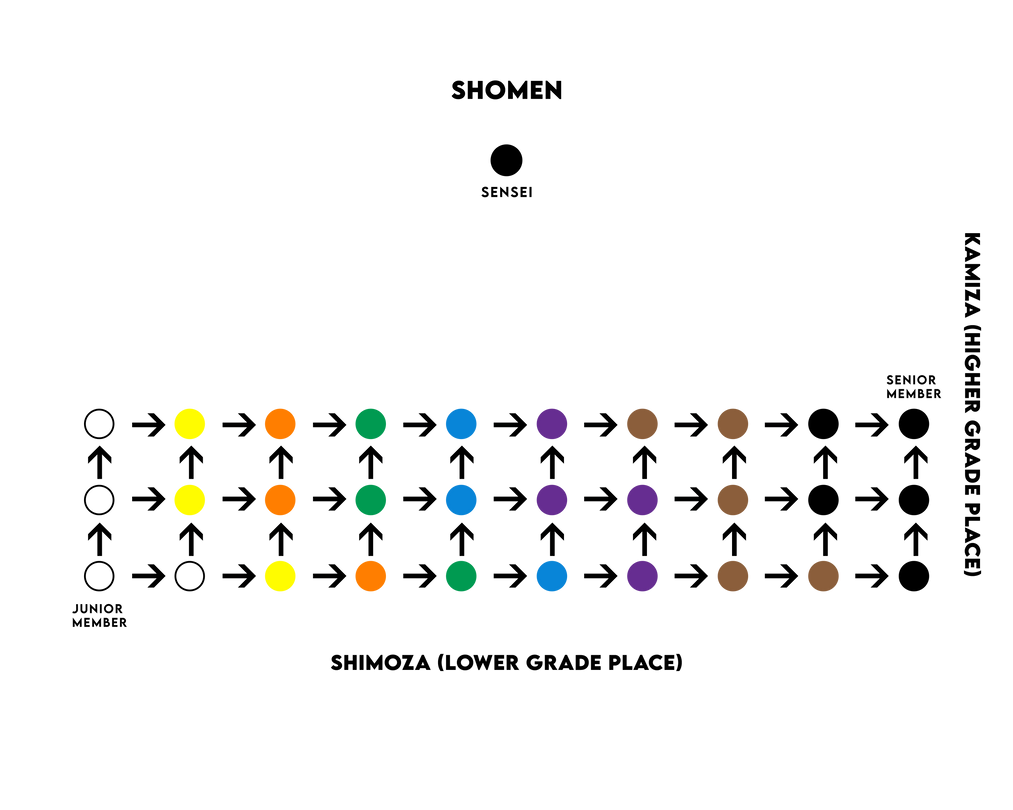IN THE DOJO
DOJO ETIQUETTE
Many of the “rules” of the dojo are learned simply by training and paying attention to the behaviour of the senior students. Central to these rules are the concepts of respect, discipline. Therefore, remember that dojo etiquette has meaning and following etiquette helps us build a culture of respect that helps us improve ourselves both inside and outside the dojo.
ENTERING AND LEAVING THE DOJO
Bow when entering or leaving the dojo.
Make a sincere effort to arrive on time or early to class. All students are expected to join the class on time.
If the class is in progress when you arrive, keep any distractions to a minimum and remain seated in seiza position until the instructor acknowledges you. Once given permission to join, perform a seated bow, then walk behind other students and find an appropriate position at the end of the last row regardless of your grade.
If you missed the warm-up, take a few minutes to warm-up before joining the class.
Do not leave class without permission (even for water).
If you feel ill, have an injury, or need to leave for some other reason, raise your hand and inform the instructor.
Inform the instructor before the class starts if you need to leave class early.
No horseplay or play fighting anywhere in the dojo.
LINE UP
Students should line up right to left with lower ranks falling in on the seniors’ left.
For students who are unable to sit in “seiza” style due to bad knees or other reasons, it is acceptable to stand and bow in the rearmost row and to the left.
IN CLASS
Attend classes on a regular basis
Always show good spirit and a positive attitude in class.
Always pay attention, learning how to maintain focus is part of your training.
Do not walk in front of other students or the sensei.
When asked, give criticism respectfully and always take criticism gracefully.
There should not be any talking while in class, too much talking can be a distraction to the other students.
Disrespectful behaviour or conversation will not be tolerated in the dojo.
Practice your kihon and kata outside of class.
DRESS REGULATIONS
A plain white regulation karate-gi is to be worn while training. A SKIF badge or Chinese calligraphy may be affixed to the left chest area. Sleeves and pants must be long enough to cover the elbows and knees. The obi (belt) should be tied low around the hips in a square knot. The label end of the belt should be on the right side after the belt has been tied.
COUNTING IN JAPANESE
1 Ichi 6 Roku
2 Ni 7 Shichi
3 San 8 Hachi
4 Shi 9 Ku
5 Go 10 Ju

COMMANDS FOR THE START AND END OF TRAINING
As a general rule, commands issued at the start and end of training sessions are performed by the most senior member in attendance (in terms of rank, number of years training, etc.)
START OF CLASS
Seiretsu (Meaning: Line up)
Seiza (Meaning: Sit [in the Japanese “Seiza” style, kneeling with the legs tucked underneath])
Mokusō (Meaning: Silent meditation)
Mokusō yame (Meaning: Halt meditation)
Shōmen ni rei (Meaning: Bow to the front, the acknowledgement “Oss” is not used when bowing to the front)
_______ Sensei ni rei (Meaning: Bow to _______ Sensei). Note: When bowing to more than one instructor: Sensei-gata ni rei (Meaning: Bow to the instructors)
Additionally, “Sensei” may be substituted with another title depending on the title of the instructor.
Otagai ni rei (Meaning: Bow to one another)
Kiritsu. Hajimemasu. (Meaning: Stand up. We will begin.)
END OF CLASS
Seiretsu (Meaning: Line up)
Seiza (Meaning: Sit [in the Japanese “seiza” style, on the knees with the legs tucked underneath])
Mokusō (Meaning: Silent meditation)
Mokusō yame (Meaning: Halt meditation)
Dōjō-kun (Meaning: Rules of the dojo)
Shōmen ni rei (Meaning: Bow to the front)
_______ Sensei ni rei (Meaning: Bow to _______ Sensei). Note: When bowing to more than one instructor: Sensei-gata ni rei (Meaning: Bow to the instructors)
Additionally, “Sensei” may be substituted with another title depending on the title of the instructor.
Otagai ni rei (Meaning: Bow to one another)
Kiritsu. Owarimasu. (Meaning: Stand up. We have finished.)
